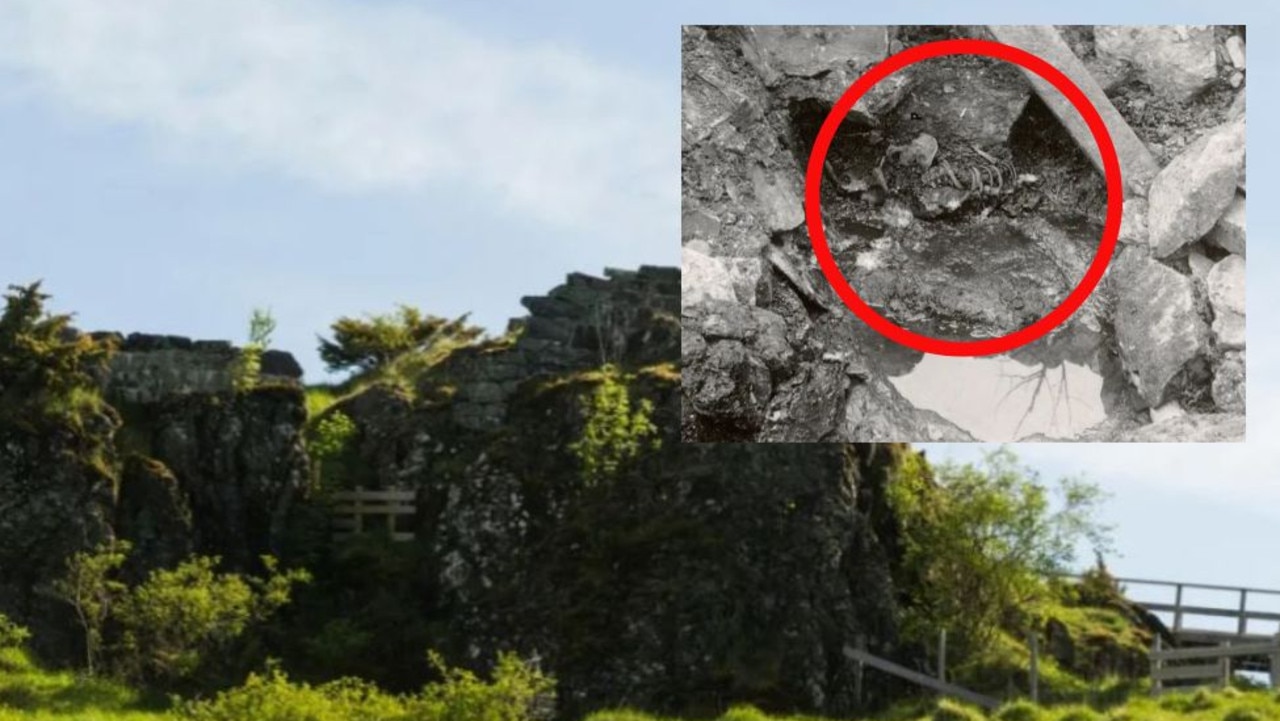The Balinese Priestess who returned from the dead
“WHEN they checked my body, they saw I was cold. My skin was white. I had no pulse. I had stopped breathing and they thought I was dead.”
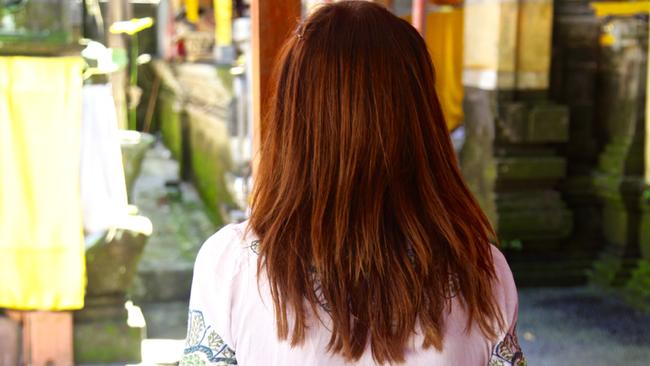
BALI’S status as a health and wellness mecca owes much to Ketut Liyer, the traditional healer made famous by Eat, Pray, Love.
“When I met him in 2002, I was a f***ing wreck of a woman — shamed, skinny, terrified, lost, and trapped inside a mind that felt like a caged and starving wolf,” wrote Elizabeth Gilbert, author of the best-selling memoir.
“I spent the next two years transforming my life because of one sentence that an old turtle of a man said to me on his porch one night.”
Following the book’s release in 2006, Liyer was also transformed into a rock star guru who attracted thousands of tourists to his home in Ubud, a fairytale-like highland town beset with Hindu and Buddhist temples known as the spiritual capital of Bali.
But according to many of those who followed in Gilbert’s footsteps, Liyer was a huckster who got rich selling flippant love spells and generic palm readings themed on health, wealth and offspring.
“Ketut Liyer? You mean Ketut Liar,” was a stock joke in Ubud.
Even Gilbert ruminated on Liyer’s chicanery when the ninth-generation medicine man, who was thought to be 100 years old, passed away in June.
“He pretended to read my palm, but that wasn’t even the point. It never was with Ketut. Many of you had palm readings from Ketut over the years, and you know he was kind of full of bulls**t, right?
“[The] guy was so blind, he couldn’t even see your hand, much less read its detailed lines.”
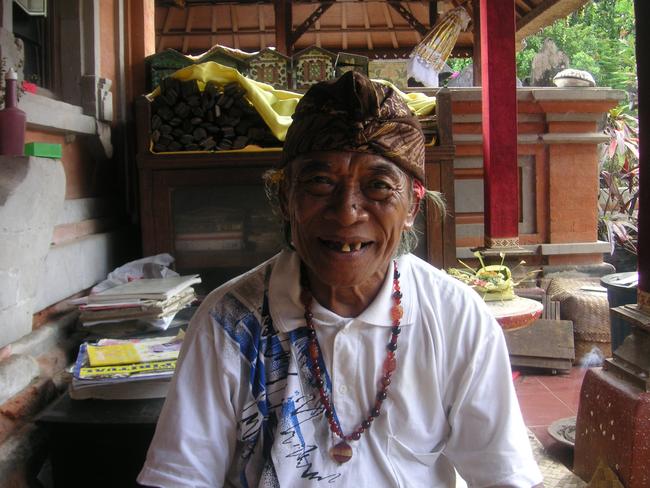
So I was somewhat sceptical when Uday Rao, general manager of the Four Seasons Resort in Ubud, suggested I write a story on Ida Panditha Mpu Budha Maharsi Alit Parama Daksa, a Hindu High Priestess absorbing some of the business left by Liyer’s void.
And she happens to be a revenant — a person who’d returned from the dead.
“I saw Ida Resi about four or five times at a stage in my life when I was trying to confront my personal feelings,” Rao said.
“With each visit, I could feel internally how I was transforming. And I specifically remember that during my last visit I was finally able to forgive myself for my past. I obtained complete clarity regarding the purpose of my life — the reason I was here, the right path for me and the steps I needed to take to achieve my goals. She is somebody who profoundly changed my life.”
Rao, who is Hindu, said his experience “was not about religion or the belief in a higher power from above”. Rather, it was ground in the simple hope Ida Resi Alit could help him find inner peace, much the same way Liyer helped Gilbert.
THE TRANSFORMATION
“It’s a long story. I never wanted to be like this,” Ida Resi Alit says.
“When I was younger, all I wanted was a good education and a career. But after I finished high school, I travelled to Bintan [a special economic zone near Singapore] looking for a job and nothing happened.
“After a few months I ran out of money, so in I came back to Bali and looked for a job here. But again nothing happened and I became very depressed. I wondered what was happening to my life? “Why were things not working out the way I’d planned?
“Why couldn’t I be like my friends? They all had jobs. They all had money. What was wrong with me?”
At this point the High Priestess’ voice cracks as though she is about to cry, engendering a very tangible stab in my heart. Revenant or not, Ida Resi Alit has an uncanny ability to connect with strangers on a deep, emotional level. I’m asking the questions but feel it is she who is interviewing me.
The High Priestess continues with her story.
“My mum saw I was getting more and more depressed, so she spoke to my great uncle, who is a monk, a holy man, and he suggested I needed water purification to get clarity. I agreed to do it but felt nothing. So my uncle suggested I should try meditation instead. I tried it five or six times and again nothing happened. I just felt bored.
“Then one time I was meditating and my body started to feel very strange. I felt sick to my stomach and started chanting in a language I didn’t know. Afterwards, I tried to repeat the chants but I could not remember what I’d said. But for the first time in my adult life, I felt really calm. I felt good. Before my mind was always so busy and crazy, but suddenly I was at peace.
“From that point on I started meditating every day, and at every meditation I started chanting these strange words. Then one day I was meditating and I entered a trance. My family started worrying. ‘Why is she in meditating so long?’ they asked. When they checked my body, they saw I was cold. My skin was white. I had no pulse. I had stopped breathing and they thought I was dead. So my uncle said if I live, he will make me a priestess.
Five or six hours after she fell into a trance, Ida Resi Alit’s fingers started moving again. Slowly she opened her eyes, though a few more hours would pass until she regained the power of speech. When her great uncle asked her where she’d been, she told him she didn’t know. She couldn’t remember a thing.

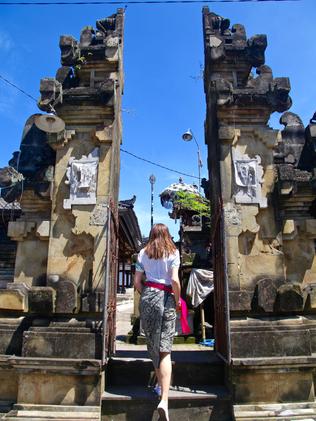
THE ANSWERS
In the days that followed, Ida Resi Alit refused to accept she was a revenant or a holy vessel, as she is now described.
“I didn’t want this. It was not part of my plan,” she says. Nevertheless, she followed her uncle’s cue. Two weeks later she met with The National Board of Ordination of The Hindu Dharma Association in Bali and underwent a process of spiritual examination.
“Some of the priests were against me because I was so young,” she recalls.
“They said the rules say I should be at least 35 or 45 years old to be a high priestess. They also said I must be married with children or grandchildren. But most of them supported me and allowed me to begin my training. The transition took a year.”
I ask the High Priestess how it makes her feel to purify people with water. Does she feel their insecurities? Can she read their pain?
“In that moment I just focus, I cannot have any feelings,” she says.
“I simply do my work because it is my duty as the High Priestess.”
When I ask her about particular people she’s helped over the years, she tells me about two cases: an otherwise healthy young woman who had been possessed (possession is a legitimate medical excuse for a sick day in Bali) and lost her mind; and another story about a truck driver, a father of five, who’d lost his job and was on the verge of being evicted from his home.
Yet when I ask how things turned out for the two, says she doesn’t know; that she never saw them again.
“I never tell people water purification can do one thing or the other. It’s just a blessing” she says.
“When we take a shower, we clean the body. When we do water purification, we clean the mind, the soul, the emotional body. I can’t talk about it like a product. I can’t give any guarantee. As for the result, it depends on you.”
THE CEREMONY
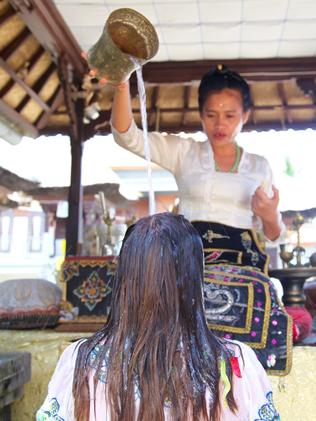
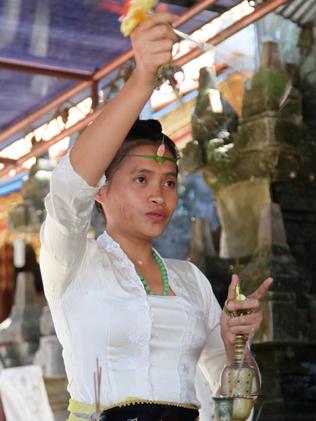
Ida Resi Alit lives in a temple surrounded by emerald-green rice fields on the foothills of Mount Agung an hour’s drive from Ubud.
When I arrive at the temple there are already a dozen tourists waiting to partake in a purification ceremony designed to cleanse the soul of negativity and karma. It’s scheduled to start at 10am, but the High Priestess runs on her own schedule. Some 90 minutes pass until she emerges from behind an intricately decorated gilt door before offering a perfunctory greeting to her guests.
The first thing I notice about Ida Resi Alit is the way she moves; she does not so much walk as she hovers or floats. With skin the colour of malt liquor, small acorn-shaped eyes and inky black hair tied in a tight bun, she also bares a stark resemblance to artistic renditions of the Buddha.
As an aide collects $30 ‘donations’ from her guests, Ida Resi Alit climbs onto an elevated shrine where she assumes the lotus position. Then begins the hour-long process whereby she turns pails of ordinary spring water arranged around her shrine into holy water via a series of sacred hand movements and ancient Sanskrit chants accompanied by chiming bells.
According to her Facebook page, Ida Resi Alit never actually learnt the chants. Rather, they were channelled through her by the divine when she began meditating at the age of 21. When the high priests of Bali first heard them, they not only confirmed the chants were real but conceded they were more complex than anything they’d heard before.
Irrespective of where it comes from, the High Priestess’ chants are music to the ears — yodelled in a voice more befitting a shrivelled old monk than the elflike 30-year-old seated before me. When I close my eyes and focus on the sound, I feel a tingling in my head and in the tips of my toes.
With the water now blessed, the high priestess invites her guests to approach the shrine for purification. “Feel free to express your emotions,” she says while ladling water over their heads. “Open your heart and mind. Stamp your feet and make lots of noise. Go deep inside yourself and find your most compassionate and humble being.”
Some of the recipients laugh. Some of them cry. Others just stand there like stunned mullets wondering what all the fuss is about. “I came with an open mind, but I felt nothing,” an Australian woman at the ceremony tells me.
Before departing, I ask her one more question: “You never found a job. But did you find happiness in the end?”
The High Priestess emits a delicate childlike laugh, a verbal manifestation of cherry blossoms drifting in a soft breeze. “Happiness or sadness is not important,” she explains.
“Happiness like the wind. It comes and goes. Even though I am the High Priestess, I still get upset.
“What’s more important is acceptance — of yourself and the world around us.”
- For more information on Ida Resi Alit visit her website, www.idaresialit.com.
- Ian Lloyd Neubauer is a Sydney-based journalist and photojournalist with nearly 20 years and experience reporting in Australia, Southeast Asia, the Pacific and the Middle East. In July he contributed a disturbing photo essay to News.com.au of an anti-Semitic rally he got swept up in while on assignment in Iran. Follow Ian on Instagram @adventure_before@dentures.



